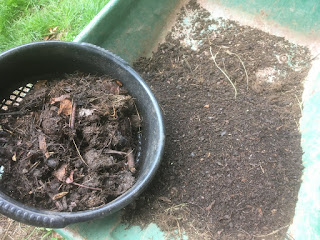Compost. A great word! It can actually mean two
things:
- The process of
rotting. We compost food left over from the canteen in our
hot RIDAN composter. We mix it with sawdust so it can rot down more
quickly without getting too smelly!
- A growing medium. We use bags of compost for potting up our seedlings and potting on plants. Compost is different from soil but both are used to grow plants in.
Compost is made from the
process of rotting (point 1 above) – so anything that was previously alive can
rot down and create compost (point 2 above).
We sieve our compost
heap once it is well rotted. It turns a lovely black colour and the
sieved compost is fine and crumbly. We have been adding it to our
raised beds both in the polytunnel and outside to add nutrients to the
soil.
We have also used some to pot up seedlings in the past.
If you are wondering, soil is
also a growing medium. Soil is
the thin layer of material covering the earth's surface and
is formed from the weathering of rocks. It is made up
mainly of mineral particles (tiny bits from the rocks), organic materials
(things that used to be alive but have now died and rotted down – like leaves
or twigs), air, water and living organisms (bugs, bacteria and mini-beasties)
—all of which interact slowly yet constantly. Soil is talked about
according to the type of rock that is it formed from – like clay, sand or
chalk. Our garden has quite “clayey” soil so we need to add composted
material to open it up and improve the structure. The perfect garden soil
is called loam – every gardener’s dream. It feels soft and crumby between
your fingers. I love loam! Do you?
















